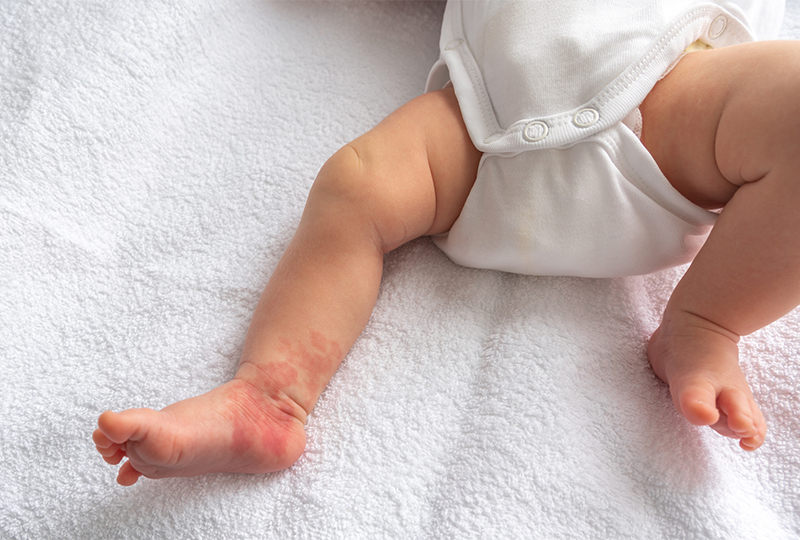How to tell what type of birthmark your child has — and if it will fade or be permanent.
You can’t take your eyes off your new baby, inspecting every inch of their little body, from head to adorable toes. In doing so, you may have noticed a birthmark — an area of skin that looks different from the rest.
Fortunately, birthmarks are rarely cause for concern.
“Most birthmarks are nothing to worry about,” said Dr. James Phillips, a pediatric otolaryngologist (ear-nose-throat specialist) who performs head and neck surgeries at Monroe Carell Jr. Children’s Hospital at Vanderbilt. “However, understanding the type of birthmark your child has can help determine if any treatment is necessary, and whether it may fade with time or remain.”
Types of birthmarks
Birthmarks are inconsistencies of the skin that are present at birth or develop shortly thereafter. They can be raised or flat and come in nearly every color — pink, red, purple, blue, brown, black and gray. There are several types of birthmarks, broadly categorized as vascular and pigmented.
Vascular birthmarks
Vascular birthmarks occur when blood vessels under the skin don’t form properly. These types of birthmarks are typically red or pink and can range from small spots to larger patches.
- Salmon patches are light pink or red patches that commonly appear on the back of the neck (sometimes referred to as “stork bites”), forehead, eyelids or between the eyebrows (also called “angel kisses”). These marks are usually flat and harmless.
“These birthmarks, technically known as nevus simplex, are in the family of capillary malformations,” Phillips explained. “What’s reassuring about them is that they typically fade with time without needing any kind of intervention. We don’t know exactly what causes them, but they’re harmless and generally not a cause for concern.” - Hemangiomas are growths made up of blood vessels that can appear on the skin’s surface or deeper beneath it. Often referred to as “strawberry hemangiomas,” these bright red growths typically appear within the first few weeks after birth and may grow rapidly before shrinking.
“Infantile hemangiomas are very common, affecting about one in every 20 to 25 babies,” Phillips said. “While some may only show slight discoloration at birth, others can grow rapidly. Most will fade by the time a child is 10 years old, but larger or more problematic ones may require medical or surgical intervention.” - Port-wine stains are flat, pink or purple marks that resemble spilled wine. These vascular birthmarks usually appear on the face, arms or legs and can grow or darken over time.
“Port-wine stains are a type of capillary malformation, and unlike other vascular birthmarks, they tend to get darker with age,” Phillips said. “They can thicken the skin over time and may require laser treatment, particularly if they’re on the face. In addition to cosmetic concerns, the treatment can prevent the skin from becoming nodular and purple.”
Pigmented birthmarks
Pigmented birthmarks form when excess melanocytes (the cells that give skin its colors) group together or when there’s skin overgrowth. These birthmarks are generally tan, brown, black or blue.
- Mongolian spots are bluish-gray patches that can easily be mistaken for bruising. They typically appear on the lower back or buttocks and are most common in babies with darker skin tones, such as those of Asian, African or Hispanic descent. These spots can be quite large but are harmless and typically fade by the time a child reaches school age.
- Café-au-lait spots are light brown birthmarks that can occur anywhere on the body. These marks may expand as the child grows and usually do not fade. While one or two spots are typically harmless, having multiple spots can sometimes indicate an underlying genetic condition like neurofibromatosis. If you notice three or more of these spots on your child, be sure to mention it to your pediatrician.
- Congenital nevi, or moles, are common birthmarks that are usually brown or black and can be flat or raised. Moles present at birth are called congenital nevi, and their size can vary. While most moles are benign, larger congenital nevi may slightly increase a person’s risk of developing skin cancer later in life. That’s why it’s important to monitor them for any changes.
Should you treat your baby’s birthmark?
In most cases, birthmarks don’t require any treatment and will fade or disappear on their own. However, some birthmarks — particularly those that grow rapidly, cause discomfort or are located in sensitive areas — may require medical treatment with medication, laser therapy or surgery.
“It’s always a good idea to ask your pediatrician about any birthmarks during those first few visits,” Phillips advised. “If the birthmark begins to grow, or if the area becomes raised, it’s something that should be brought to your doctor’s attention.”
When to see a doctor
While most birthmarks are harmless, there are some red flags parents should watch out for:
- Rapid growth. If a birthmark grows quickly, particularly in the first few months, consult a doctor.
- Changes in color or texture. Any darkening, lightening or changes in surface texture may need medical evaluation.
- Physical symptoms. A birthmark that causes pain, itching or affects daily life (such as a hemangioma near the eye affecting vision) should be checked by a health care professional.

Personalized care for your child
The Vascular Anomalies team at Monroe Carell Jr. Children’s Hospital at Vanderbilt evaluates and treats children and young adults with vascular anomalies and tumors, including hemangiomas, other vascular malformations, vascular syndromes and unknown lesions.




